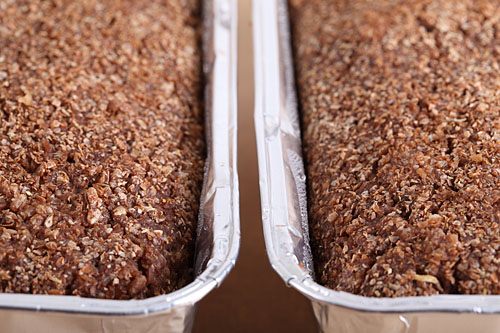
Imaging: 10 hours in the oven at night and then awaken to the aroma of the fresh rye bread!
As a child I loved this dark, moist rye bread, which in Holland we call Frisian Rye bread (‘Fries roggebrood’ or our version of a fine pumpernickel, however the structure is more compact and very moist). I never thought that one day I would make it myself and the result would be so rewarding! You have to be patient with this one, because it takes about 10 hours in the oven, but if you put it in before going to bed you will wake to a wonderful smell of fresh rye bread that has magically transformed itself while you were sleeping. I like it best with mature Dutch cheese with cumin or cloves. Rye bread is also eaten with bacon to accompany split pea soup, one of our Dutch culinary traditions. And did I mention it is very healthy too, one of the best ways to get that recommended daily dose of fiber…
makes 2 loaves
Ingredients for the Rye Bread
700 g broken whole grain rye (cracked rye)
200 g whole grain rye flour
50 g fine rye flour (can be substituted with wheat flour)
50 g wheat flour
2 tbsps date syrup or molasses
13 g sea salt
700 ml HOT water
approx. 200 ml water at room temperature
wheat germ for coating
Note: We understand if you do not want to use tin foil. We want to experiment with other options like pullman tins, Dutch ovens or maybe a tin with wet baking paper lid, securely fastened with string. If you use anything else, we would love to hear about it of course!
Making the Rye Bread
Before you start you need two pans of about 20 cm long by 14 cm wide and 4.5 cm high to put the loaves in when they go into the oven. We use (disposable) aluminum pans, the same ones that are used to make sugar loaves. These pans have different measurements (21x10x6) but almost the same volume, so they work great too, the loaves are just a bit smaller and higher than the pans originally used for this type of recipe. Just aim for a volume of about 1260cm³ / 76.89 in³.
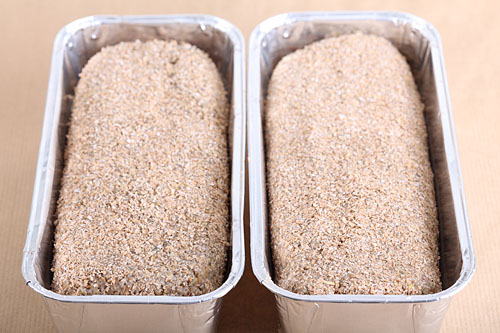
Before their night in the oven the loaves get coated in wheat germ…more fibres please
Start with placing the 700 g broken whole grain rye in a (plastic) bowl and add the HOT water (just off the boil). Mix with a wooden spoon, cover and leave to rest/soak for 2 hours. The broken rye grains will absorb all the water and become soft, this is very important for the rye bread to become a success! Preheat your oven at 110° Celsius/ 230° Fahrenheit (yes, you bake this bread at a low temperature!). Now add the rest of the ingredients, including the 200 g of water at room temperature.
Note: the adding of the exact amount of water is a matter of experience and depends on how soft you want the rye bread to become. You will see what works best for you and your own ingredients as you make the recipe more often. Now knead well by hand or mixer until combined. Be careful a KitchenAid style mixer can handle it because the dough is very tough and sticky, use your hands if your mixer gets too hot or starts acting funny. We use a bigger spiral mixer, brand Hauessler from Germany, that is up to this sort of job. Divide in two equal portions and shape them into loaves that fit in the pans. Roll the loaves through the wheat germ until all sides are thinly covered and place them in the pans.
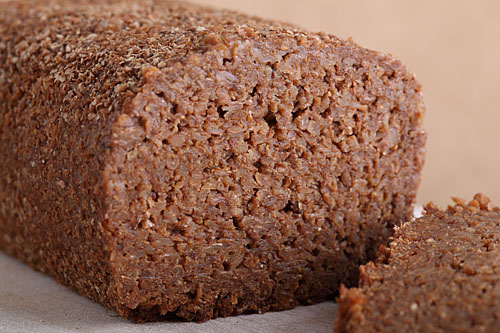
The finished product is lovely and moist and keeps very well in the fridge
Now cover the pans completely with 2 layers of aluminum foil so no moisture can escape. Place the loaves in the preheated oven and leave them there for 9 to 12 hours (we did 9.5 the first time and 10 the second run and they both got good results). Take the pans out of the oven but DO NOT OPEN until completely cooled to avoid losing moisture! This can take several hours, so curb your curiosity.
The baking period needs to be this long because the rye substance is very compact and contains almost no air, making heat transfer slow. This is a very old Dutch (Frisian) recipe, we think this bread was normally baked (cooked almost) during the night on the residual heat of a stove.
Cut into 3-4 mm slices with a wet bread knife (dip in water after each slice), the bread is very crumbly and sticky. You can make little packs of sliced rye bread that keep very well in your fridge for over a week. You can keep the rest for much longer in the freezer.
We like to thank ‘roggebrood fanaat’ at bakkerswereld.org for this excellent recipe.




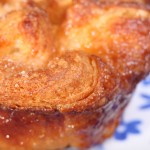
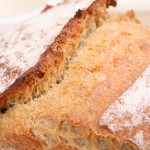
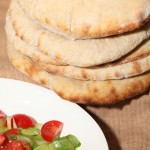
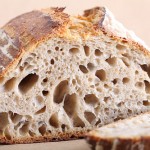

Kees docter says
3300 gram cracked rye
32gram diastatic malt
3500 water
In oven in pan with lid for 10 hours at 350 F and after couple hours oven temp back to 250 F
after it comes out the oven add 1000 gram water over the top
And cool it down 5-6 hours later put the rye in the mixer add
1400 gram rye sour and
100 gram salt.
20 gram calcium propionate
Approx 700 water
to make it workable after the mix when it looks mixed well scale the dough on wet table 600 grams and make Squair bricks, roll it through the wheat bran and put 5 or 6 in Pullman loaf pan.
Let it rise for 2-3 hours and bake another 8 hours at 350 and down to 250.
After the total of 8 hours let it cool down till handeble and flip the Pullman pan over.
And there you go.
Let it cool down and pack them.
Good luck
No wheat is used other then wheat bran
Weekend Bakers says
Hello Kees,
Thank you for sharing your very interesting method. That is a lot of oven time in total. But totally worth it of course.
Phoebe says
Can I leave out the wheat flour or use extra rye flour instead? (Wheat intolerance)
Weekend Bakers says
Hello Phoebe,
The wheat flour provides a little bit of gluten to hold the mass together, but it will be OK to use 50 grams of fine rye flour instead. It feels a bit like working with clay anyway.
Hope it will be a success, the bread is delicious!